Squash borers are one of the most frustrating pests for many vegetable gardeners, but it is possible to get rid of them and prevent them from destroying your plants.
In this post, I’ll show you several all-natural treatment methods to help you eliminate them, and I’ll also give you control tips to keep them from coming back.
You’ll learn all about their feeding habits, life cycle, where they come from, the damage they cause, and how to quickly spot the telltale signs of an infestation.
I’ve been growing squash in my garden for a few decades, so I know firsthand just how frustrating vine borers are to deal with. They are sneaky, and can go unnoticed for a very long time.
Since they bore into the vine, most people don’t even know there’s a problem until their plants suddenly wilt and begin to die.
Over the years, I’ve killed hundreds of these annoying little buggers. But I’m happy to say that I’ve successfully saved every one of my plants – and you can too by following my step by step process below!
What Are Squash Vine Borers?
Squash vine borers (also called “squash borers” or “squash worms”) are common pests of plants in the cucurbit (or squash) family, and they are very destructive. They’re the larvae of the squash borer bug, which is a type of moth.
They get their common name because they bore into the vines of the plant, eating them from the inside out. A trait that makes them impossible to see, and difficult to control.
You’ll only find them inside of the vine, stem, or the fruits. So if you have bugs crawling all over the outside of your plants and the leaves, those are squash bugs, and here’s how to get rid of them.
What Do They Look Like?
Squash borers look like white worms with a black head and wrinkly bodies. They start out tiny, and grow to be about one inch long.
The adults are a type of moth which, I hate to admit, is actually kinda pretty. The moths are reddish-orange with black wings and black dots down the length of their back. They’re active during the day, and look like a wasp when they fly.
Related Post: How To Control Garden Pests Naturally
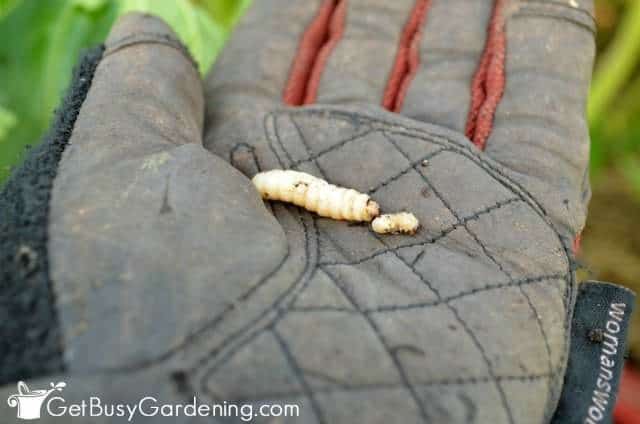
Life Cycle
There are four stages in the squash borer life cycle: eggs, larvae (borer), pupa, and adult (moth). The adults emerge in late spring or early summer, and the females will start laying eggs on nearby cucurbit plants shortly after.
They lay the eggs at the base of the plant, where they will hatch 1-2 weeks later. While they can lay a lot of eggs, the good news is that the moths are only active for about a month (usually June-July).
Shortly after the eggs hatch, the tiny squash borers will quickly burrow into the stem of the plant. As they feast they grow larger, reaching their full size of about 1″ long in 2-4 weeks.
Once they are full-sized, they will leave the vine and drop into the soil, where they’ll form a cocoon and pupate. They overwinter in the soil in 1″ long reddish-brown colored cocoons, and will hibernate until the following spring.
If you live in a cold climate like I do, there’s only one generation of squash borers per year. But in warmer climates, there can be two generations per year.
Related Post: How To Grow Summer Squash
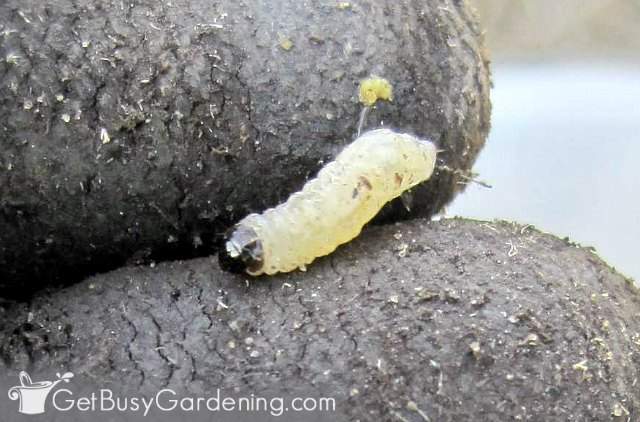
Where Do They Come From?
Since the adults can fly, squash borers could come from anywhere. They’re naturally attracted to cucurbits, since that’s their main host plant.
So, if the moths are present in your area of the world, and you’re growing any type of cucurbit plant, then it’s a sure bet they’ll find your garden.
What Do They Eat?
The main host plant for squash borer moths are vegetables in the Cucurbitaceae family. This includes all types of squash (both summer and winter), zucchini, pumpkins, and gourds, as well as melons, luffa, and cucumbers.
The borers do love squash plants the best though (hence their nickname). So, it’s much less common to find them feasting on cucumber and melon plants.
You’ll usually find squash borers eating the insides of the vines. But sometimes they will find their way into the fruits too, and destroy them from the inside out (Gross!).
The good news is that the larvae are the only stage in their life cycle where they eat plants. They are harmless in both their adult and pupa stages.
Related Post: How To Grow Winter Squash
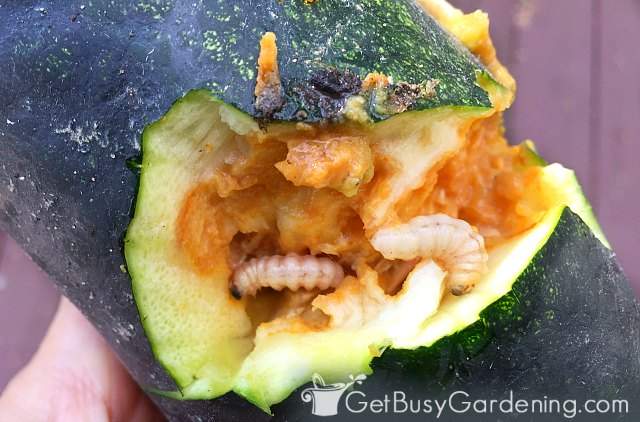
Damage To Plants
Since they eat the vines from the inside out, squash borer damage is difficult to spot unless you know what to look for.
If your squash plant has any of the symptoms below, then it’s time to take immediate action to get rid of the borers before they completely destroy the vine.
Here are the main signs to watch out for…
- Droopy leaves, or the entire plant suddenly wilts.
- Holes anywhere on the vine or stem.
- Mushy yellow sawdust coming out of the stem, vine, or fruits (this is their poop, also called frass).
- The vine is soft, split open, appears to be rotting, or is completely severed.
- Canker wounds or soft spots on the fruits.
- White worms inside your squash vines, stems, and/or the fruits.
Related Post: How To Grow Zucchini
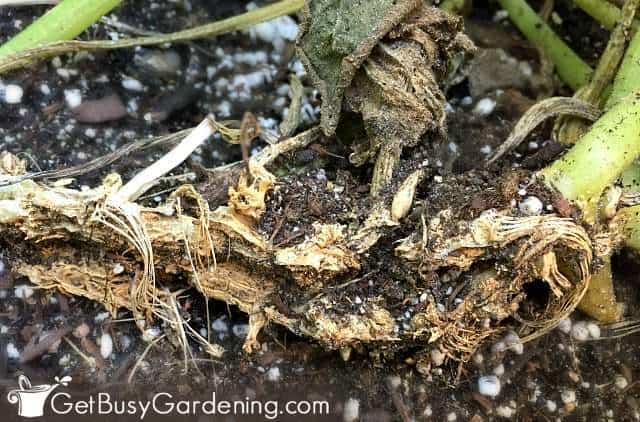
How To Get Rid Of Squash Vine Borers
Since they are inside the plant, pesticides (organic or otherwise) won’t work on them. But don’t worry, it’s pretty easy to get rid of squash borers organically by using a simple, non-toxic, and very effective method that I like to call… digging those nasty suckers out of the vine.
It takes a little bit of work, but it sounds harder than it is. And it really is the only way to get them out of the vine. Below I will walk you through how to do it step by step.
Supplies Needed
- Utility knife
- Bucket (optional)
- Liquid soap (optional)
- Water (optional)
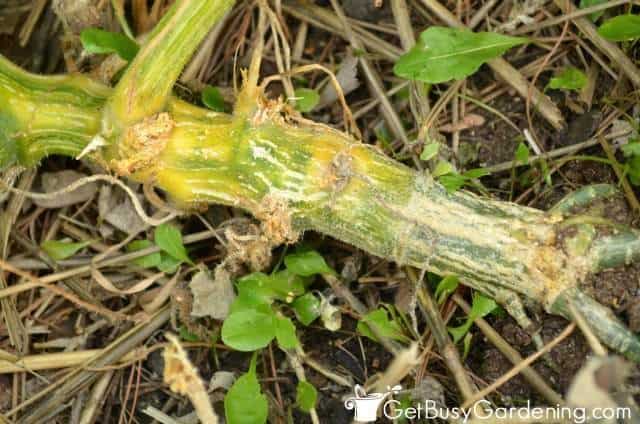
Step By Step Instructions
Step 1: Slice open the vine – Carefully slice open a small part of the vine just above the spot where you see the borer hole or sawdust mush.
Make a 1-2″ inch long cut the long way (i.e.: parallel to the vine) using a sharp utility knife. Take care not to sever the vine, you just need to open it up.
Step 2: Find the squash borer – Gently pry open the slit you made in the vine to look for the borer.
You may spot it right away, or you might need to make the cut a little larger so you can search around. It could be above or below the entry hole, but you’ll usually find them pretty close to the frass.
Step 3: Remove and kill it – Once you find a borer, pluck it out and kill it. You can simply squash it (pun intended!). Or, if that makes you too squeamish, then drop it into a bucket of soapy water.
Sometimes it’s easier to just squish it inside of the vine than it is to remove it. That’s fine, squash borer guts won’t harm your plant.
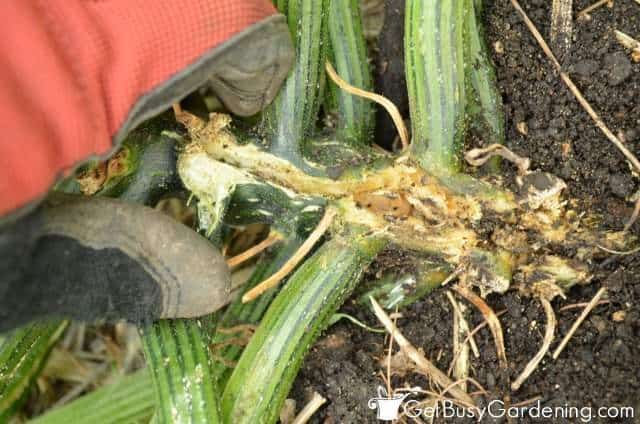
Step 4: Look for more squash borers – Continue inspecting the vine to look for signs of additional borers, and repeat steps 1-3 for each one that you find. There can be several of them inside of each vine.
Step 5: Bury the vine – Once you’re sure you’ve removed all of the borers, bury the injured section(s) of the vine with soil. Squash vines will form new roots under the soil, and the plant will become even stronger because of it.
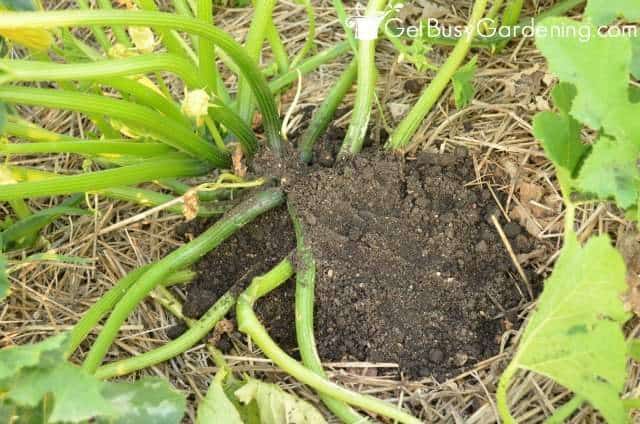
Additional Tips & Notes
Digging the borers out is the best way to get rid of them once they’re inside of the vine. And it’s so satisfying when you find them.
But sometimes you’ll see signs that there’s one inside the vine, and you can’t find anything after you cut it open.
Remember that the borers can be different sizes, and the smaller ones are much harder to spot than the big fat ones.
So don’t be discouraged. Maybe it was so small that you squished it without seeing it. Or maybe it was already fully mature and has left the vine. Just cover the injured part of the stem, and move on.
How To Prevent Squash Borers
There are lots of things you can do to prevent squash borers from infesting your plants in the first place. Use a combination of the techniques below to control their population, or even get rid of them all together.
Destroy The Eggs
Squash borer eggs are tiny, but they’re fairly easy to spot when you’re looking for them. The eggs are flat, oval shaped, and brown in color.
You’ll usually find them at the base of the stem of young plants, either at or near the soil line. But they can be anywhere on the vines of mature plants. There could be just one egg, or a few in a small cluster.
You can simply scrape the eggs off into a bucket of soapy water, or wash the vines with organic insecticidal soap to kill them. Be sure to inspect your plants regularly, and remove any new eggs before they hatch.
Related Post: Natural Garden Pest Control Remedies & Recipes
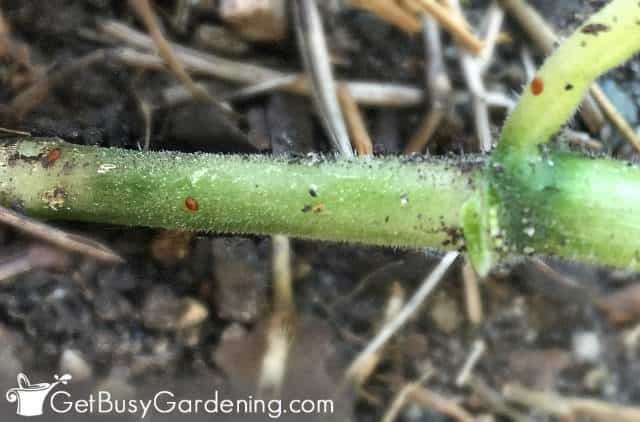
Try Sticky Traps
The adult squash borer moth is attracted to the color yellow. So, try placing sticky traps near your plants to trap them before they can lay their eggs.
These types of traps are completely non-toxic and safe to use in the veggie garden. They can also capture other pest insects too, which is a double bonus.
Use Aluminum Foil
Another great way to prevent squash borers is to wrap the stems of your plants in aluminum foil. This will confuse the moth, and prevent her from laying eggs. Here are the steps…
- Carefully dig down into the soil about 1/4″ inch around the base of the plant.
- Cut a small strip of aluminum foil, and wrap it around the entire stem of each plant.
- Push the soil back around the base of the stem, covering the bottom edge of the foil.
- Check the aluminum foil regularly, and re-wrap it if necessary.
Install Row Covers
Covering young squash plants helps to keep the borer moth from getting to the vines. You can buy row covers, or make your own out of inexpensive tulle fabric.
Keep in mind that this will also prevent pollinators from reaching your plants. So you should either hand pollinate your squash, or remove the row covers once the flowers start to open.
Destroy The Pupae In The Soil
As I already mentioned, squash borers overwinter in their pupa stage, and they hibernate in the soil. So, here are a few things you can do to get rid of them…
- Remove and destroy all of your cucurbit plants in the fall – especially any that have vine borer damage. Be sure to burn them or throw them into the trash, rather than putting them in your home compost bin. Otherwise, the pupa could just overwinter in there.
- Till or turn the soil in the fall and/or early spring to destroy the cocoons, or expose them to hungry predators.
Plant Trap Crops
Technically there is no such thing as a “squash borer-resistant plant”. Unfortunately, all types of cucurbits are susceptible to an infestation.
However, that being said, there are certain varieties that they prefer over others. They tend to really love zucchini (yellow and green) and hubbard squash the best.
Some gardeners use those varieties as trap crops to protect the less susceptible ones. A few of the borer’s least favorite varieties are butternut, tromboncino, and crookneck squash, as well as cucumbers and melons.
Related Post: How To Grow Cucumbers
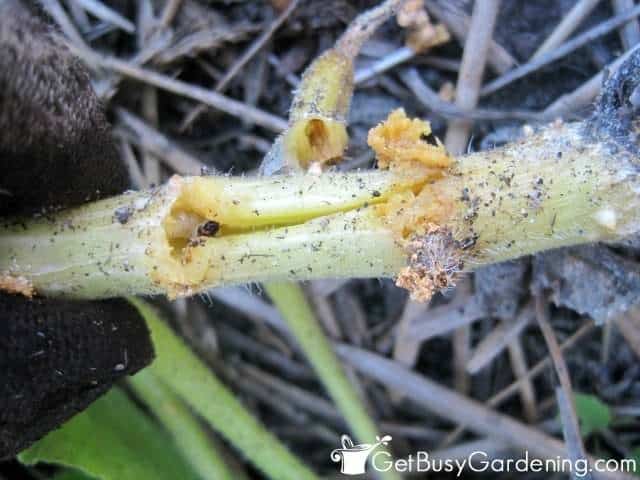
FAQs
While neem oil could kill the baby squash borers as they eat through the vine, it won’t work once they are inside the plant. If you want to try it, start applying it as soon as you plant your seedlings, and continue every few weeks until the moths are no longer active.
Diatomaceous earth can work to kill the adult moths and the larvae, but it won’t work once the squash borers are protected inside of the vine.
You can find squash vine borers inside of the stems, vines, or even the fruits of any type of cucurbit plant, including summer and winter squash, pumpkins, cucumbers, melons, and gourds.
Getting rid of squash vine borers can take some work, but it’s worth it to save your plants. Once you know the steps to take to control them, you can easily prevent them from ruining your crops.
If you’d like to learn how to make the most of your space and get as much homegrown food as possible, then my Vertical Vegetables book is perfect! It will teach you all you need to know, has tons of gorgeous photos, and includes 23 DIY projects you can build for your own garden. Order your copy today!
Learn more about my Vertical Vegetables book here.
Share your method for getting rid of squash vine borers in your garden, or your best prevention tips, in the comments below.
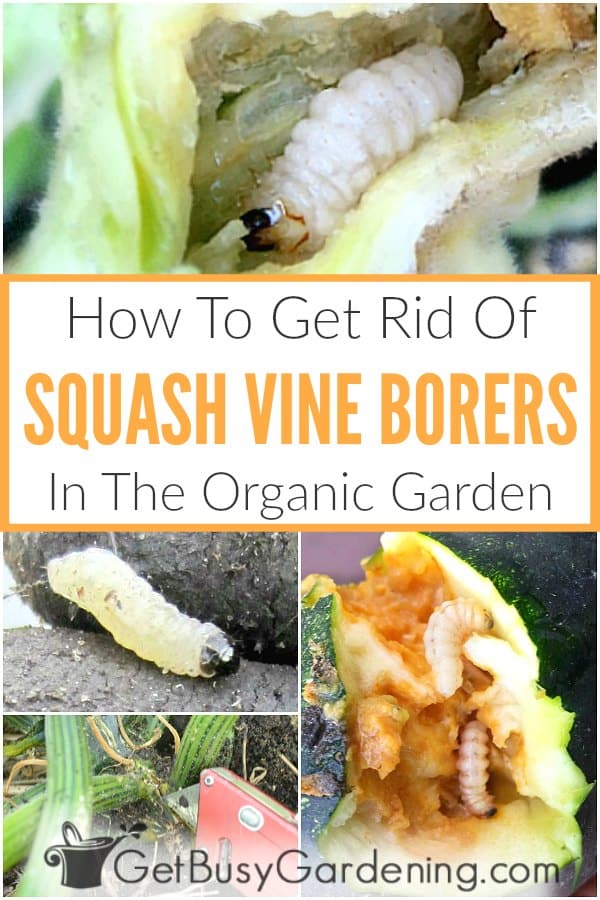
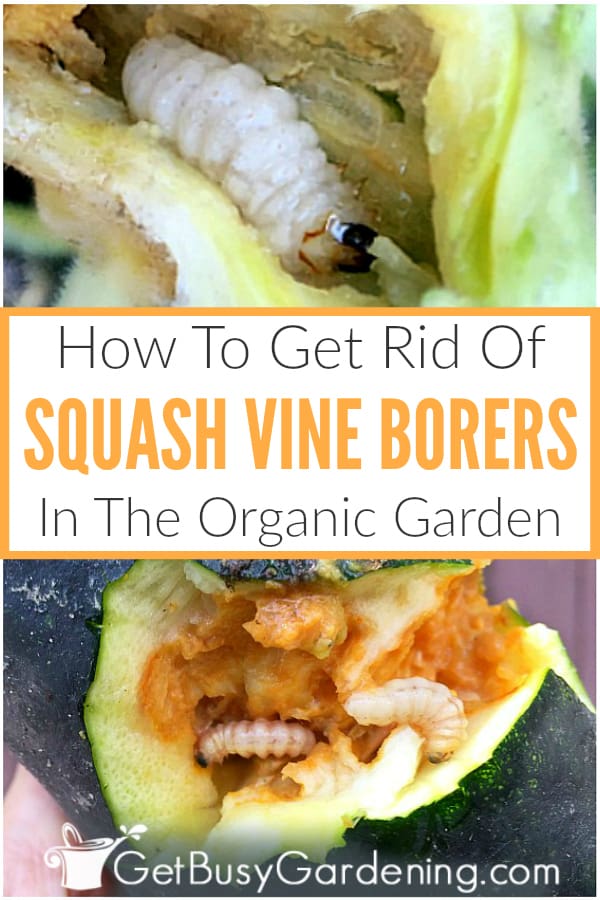
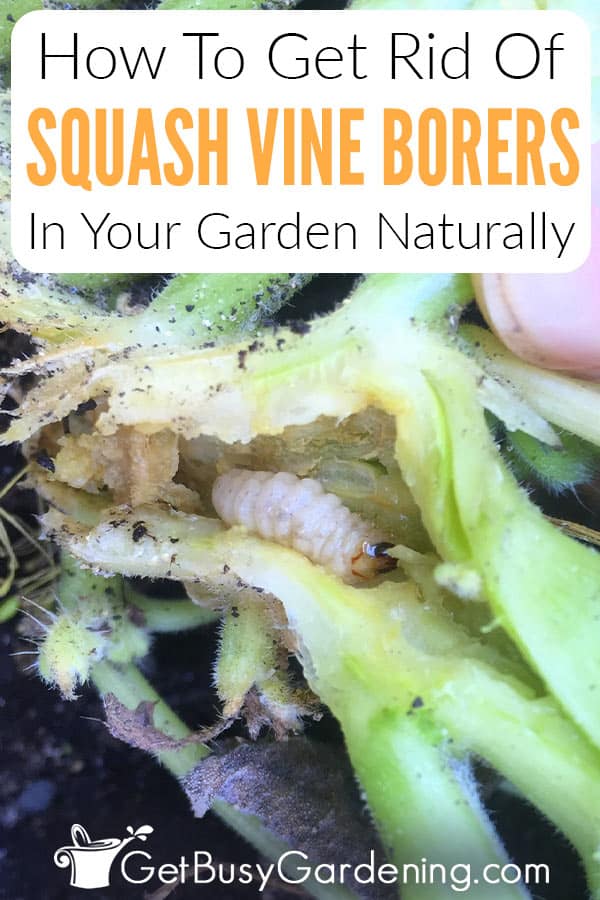

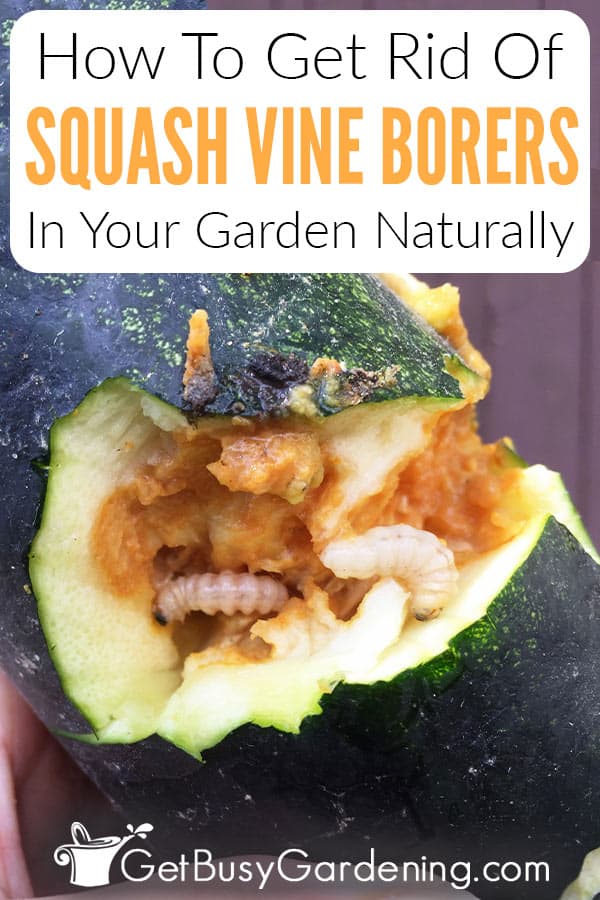
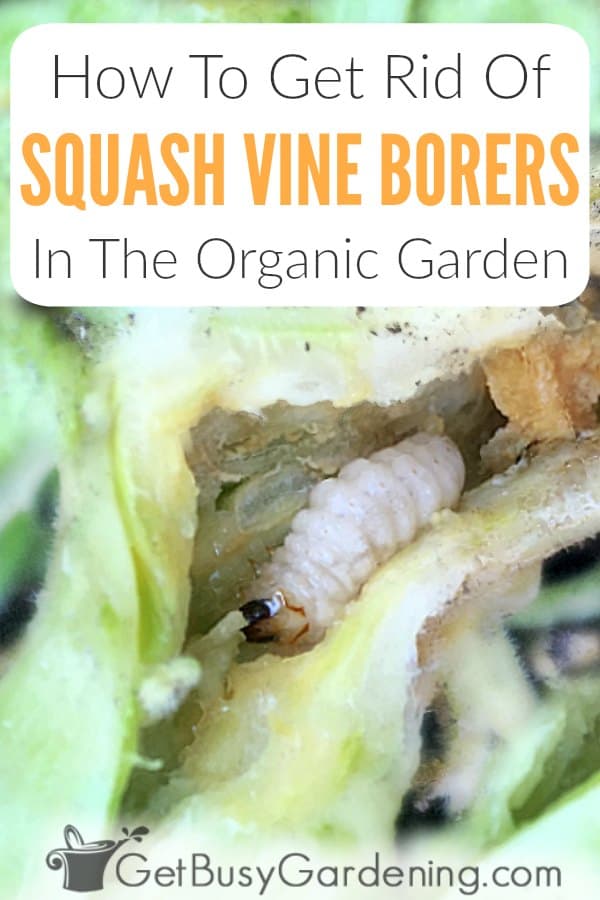
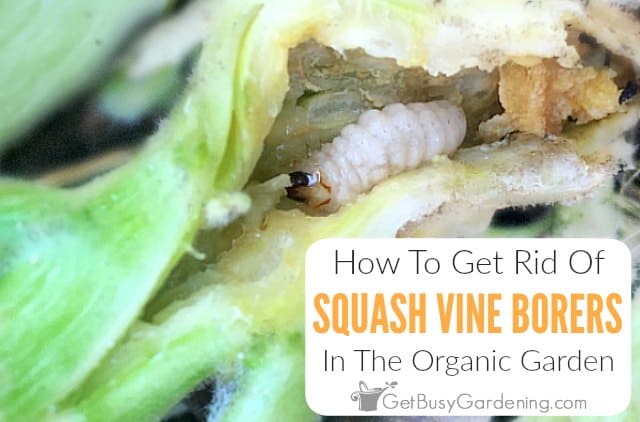

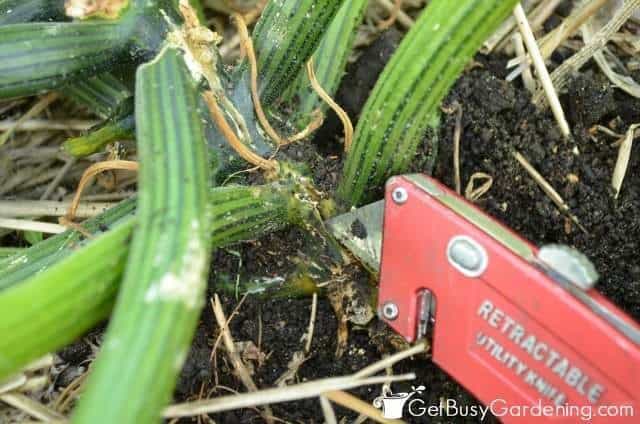


Jen says
I have gotten squash vine borers terribly the last 2 years. I heard about making a “tea” out of tobacco and pouring it over the plant, so I currently have some tobacco soaking and I am hoping this works. I have been leery of using row covers since it keeps the pollinators out too. Do you hand pollinate?
Amy Andrychowicz says
Oh, I’ve never heard of using tobacco to get rid of squash vine borers. Does it work as a deterrent? Yes, if you use row covers, then you have to hand pollinate your squash plants. It’s not hard to do it, but you do need to check the plants very regularly for new female flowers.
PlantPostings says
I remember having a problem with squash borers when I had a big vegetable garden. They infested my squash, pumpkins, and watermelons (if I’m remembering correctly). Good luck! I’m hoping row covers do the trick!
Amy Andrychowicz says
Thank you!
RandomGardener says
Thanks for the info! I’ve only grown zucchini and yellow squash, and get plenty of them, before the vines die from the borers, so I didn’t worry too much. Ofcourse, this year, I’m trying melons and butternut squash, so will have to be more careful to see if this gets affected by the squash borer!
Amy Andrychowicz says
You’re lucky to get so many squash before the vine borers kill the plants. All types of squash do equally terrible in my garden. Good luck, hopefully the borer will be kinder to your squash than mine! ?
Michael Moore says
I have also read that if you can tell where in the vine the borer is, you can push a sewing pin through the vine/stem and impale it, killing it. The vine supposedly grows just fine with the pin.
I haven’t had problems with them yet though, so I can’t say if it works for sure!
Amy Andrychowicz says
That sounds like a good idea too, thanks for sharing! I think I would want to see that I killed the borers though, and get that icky satisfaction. 🙂 I hope you never have to deal with squash borers. You might live in a part of the country that doesn’t get them. I thought they were inevitable if squash vine borer bugs are present in your area of the world.
Eldemila says
I also use pins but I put them in the crooks of the squash plants, and sometimes straight down the stem BEFORE I see any borer damage. This way, should the VB get in tot he squash if it grows it won’t be able to go much of anywhere in the stem and most likely die from growing in to the pin. I use glass head pins, the ones with the ball on them. Just remember they are in there when you go to pull out your squash!!!! Did this last year and had good success. More of a problem are the squash bugs!
Ron Mitchell says
If you grow butternuts you will not get any borers as they find the stem to wiry. Also, dump used coffee grounds on the stems of the other varieties and the borer will not lay any eggs. I’ve been using some used coffee grounds around the stem of my plants now for some years. It appears to be quite effective as I do not have the problems I used to have. It needs to be constantly replenished. From what I understand the scent of the grounds confuse their little brains. I believe Starbucks will give you a bag (along with the filters) of used grounds if you ask them. At least they were a couple of years ago. And I understand that butternut varities have too tough and wiry a stem for the borers.
Amy Andrychowicz says
I have had squash borers in my butternut squash before. They don’t seem to be picky at all about they type of squash they infest in my garden. 🙁
Thanks for the tip on the coffee grounds, I’ll have to try that. How often do you apply it? In the spring only, or throughout the growing season?
Ron Mitchell says
I start to put the grounds down around the stem when they start to put on growth. I keep putting it on for a couple of months about every week or so, especially after a rain fall. When I think the squash borers are gone for the season, I stop. I’m surprised hearing that you had them in your butternuts as most literature I’ve come across claims that the stems are too wiry. It goes to show you that not everything you read is always 100%.
Amy Andrychowicz says
Awesome, thanks so much!! I’m totally going to make a note to try the coffee grounds next year!
I don’t know, maybe my squash borers are special mutants of some sort, LOL! They are ruthless, especially at our community garden. I pulled 3 tiny ones out of one of my zucchini the other day – the actual zucchini, not the stem. It’s as if the eggs were laid right on the squash itself or something. Crazy!!
Randy says
The vine borer traps work!!!!! Ive been getting 20 to 30 a week out of the traps.
Coffee grounds sound to good to be true but why not..
With row covers and the traps I just might get a good harvest or two this years.
Amy Andrychowicz says
Awesome, so glad to hear that your squash borer traps worked for you!
nancy snider says
I believe you are correct about the butternuts.. last year I had both zucchini and butternut the beds were side by side and I only lost the zucchini.. perhaps they like the zucchini better but left the butternut completely alone.
Chuck Hamlett says
Amy, after losing my squash crop two years in a row I did some research. By reading about companion planting, I learned that radishes repel the moth that lay the borer egg. I tried it and have not lost a squash since. Maybe it will work for you. Good luck.
Amy Andrychowicz says
Wonderful, thanks so much for sharing your experience using plants to repel squash borer moths! I will definitely have to try radishes!
Chuck Hamlett says
Great! Good gardening to you!
Gabrielle Muething says
i have radishes and nasturtiums in my square foot garden, with my spaghetti squash which is trellised. About every other ‘knuckle’ on the squash has been bored 🙁
Amy Andrychowicz says
Oh bummer! Sorry to hear repellent plants didn’t work for you. Those squash vine borers are ruthless. 🙁
Chuck Hamlett says
On boy! What would gardening be without these challenges. Good luck with your squash.
Amy Andrychowicz says
Haha, that is so true! Thank you. 🙂
Bliss says
I planted so many radish in and around my squash and it didn’t help at all, this was the worst year ever,I lost every single plant. Wish I could treat the soil. I’m going to try row covers next year. I live in zone 7
Amy Andrychowicz says
Shoot, sorry to hear it! Unfortunately, even if you treat your soil, the squash vine borer bug can fly, so they will still probably still infest your plants. 🙁 I hope the row covers will work for you!
Kentosaur says
Great read! I had my first experience with squash boring worms last year, causing all my plants to get wilted and pulled out.
Amy Andrychowicz says
Oh bummer, sorry to hear you lost all of your plants to squash vine borers. Hopefully some of these tips will help you get rid of them next year.
Babs says
A method I heard about but have not tried yet to rid of squash pest was to use a syringe and inject the vine with something to kill the borer. Have not tried this because I do not remember what they used — soapy water or a solution to kill the borer. Any ideas of what could be used to kill the pest and not hurt the plants? Thanks, `
Amy Andrychowicz says
Someone (in the comments above) mentioned injecting the vine with hydrogen peroxide to kill the squash borers, but I haven’t tried it.
Pat Cowles says
Inject the stems with hydrogen peroxide. Use one of those turkey injectors. Works like a charm to control the borers.
Amy Andrychowicz says
Holy smokes, I’ve never heard of injecting the vines with hydrogen peroxide to kill squash borers! I’m totally going to try it this year. Thanks for the tip!
Brian Moore says
When did you inject the plants? Before you saw saw signs of borers or after?
Jax says
How do you inject the stems? They aren’t hollow. Unless you mean waiting for the borer to enter. But by then you might as well skewer them with a wire.
CW says
I’ve used this method for years and it works well. My problem is squash bugs. Other than constantly picking them off, do you have any suggestions for them?
Amy Andrychowicz says
Yes, I have all kinds of other suggestions in my post about squash bugs… How to Control Squash Bugs Organically
Barbara says
Hi Amy,
I love your website, I’ve found some very helpful information. I have a question, how to handle the borer when you trellis your squash and the vine is no longer on the ground. If borer has entered your vine and you can’t cover the injured part with soil because it is too high up on the trellis. Any suggestions?
Thank you.
Amy Andrychowicz says
Thank you, glad to hear you like the site! I also trellis my squash vines. The squash borer moth tends to lay the eggs near the soil line. I check my vines regularly for eggs, and remove those when I find them. I also check often for signs of squash borers, so I haven’t had them get very far up the vines before I dig them out, then I can still pile dirt up to bury the vine.
If the squash borers are too far up the vine by the time you find them, then just be extra careful digging them out so you cause as little damage to the vine as possible. You can also take a piece of cloth or elastic type fabric and tie the vine at the spot where you sliced it open (like putting a band-aid on the wound).
Barbara says
Thank you so much Amy, I’ll definitely do that.
Jill says
Thank you for the info. I will make a note of this for next year. Where do these bugs come from???
Amy Andrychowicz says
They overwinter in cocoons in the soil, and emerge as adults in the spring. Shortly after that, the squash borer bug lays it’s eggs on the base of the squash vine. Once they hatch, the tiny squash borer worms burrow into the vine, growing larger as they feed. They’re very hard to see, so easily overlooked.
Michael Moore says
I came back today from a week's vacation to find my garden doing well, except for signs of squash borer in my pumpkins, squash and cucumbers. Disappointing! I'm going to have to spend some time attacking them tomorrow.
Amy Andrychowicz says
Oh bummer, sorry to hear you found signs of squash borers. Hope you’re able to get rid of them quickly.
Amy Biddle says
I had this very same problem this year. I did not know that you could get the squash vine borers out and cover the stem with dirt. I will have to try this next time. Thank you for the info.
Amy Andrychowicz says
Yes, I dig the squash borers out of the vines every summer. It’s a bit of work, but very effective. The plants may droop a bit for a day or so, but should pop back pretty quickly.
Amy Andrychowicz says
Since our growing season is so short here in MN, I usually only get one or two squash off a plant before the squash vine borers are large enough to start killing the plants. So unfortunately, if I want a good harvest, I must fight the borers throughout the summer to save my squash plants.
MIKE S says
I HAD POOR SQUASH RESULTS IN THE PAST DEPENDING ON THE PARTICULAR SPECIES GROWN, SOME WOULD SEND OUT ALL MALE FLOWERS AND THE FEMALE FLOWERS WOULD WITHER AND ROT AT THE END OF 1” SQUASH BUDS. I STARTED HAND POLLENATION THREE YEARS AGO AND HAVE GOTTEN BUMPER CROPS SINCE. I’D CHECK THE PLANT FLOWERS EVERY OTHER DAY AND ‘SEX’ AS NEEDED.
Amy Andrychowicz says
Wow, that’s awesome! Great job!
Random says
Did you get any squash before the vine borer got the plant? Usually, I get plenty and just give up the plant by the time it is infested.